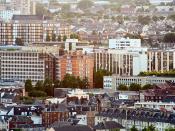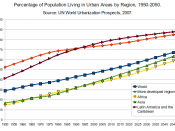Urbanization TrendsWhen an American thinks of an urbanized area they think of lots of people, tall buildings, permanent houses, paved streets and sidewalks, water and sewage systems and so forth. This may be the case in middle class urban areas; however, urbanized areas in the poorest countries of the world are quite different. Africa, one of the poorest countries, suffers from a shortage of infrastructure causing slum-like conditions in urban areas. According to White D. (2006) "Almost 72 per cent of its urban residents, it calculates, are in slums". Because there is no clear legal basis for building housing areas are not permanent. Streets and alleys are made of compacted refuse. There is no city sanitation so sewage runs in open ditches leading to the ocean. Despite these types of issues urbanization continues in this poor country.
African people look to the city for a better life. Urbanization brings modernization and advantages that draw people in.
Poor people flock to urban areas in hopes of finding employment, food, shelter, better medical care, education and the like. Many of Africa's cities are rapidly urbanizing for this reason.
Zimbabwe's rapid urbanization has caused rapid population growth which causes high demand for services such as food, shelter, medical care et cetera. The economy is staggering under the demands and left with limited recourses to address the needs of the city. Many have to live in substandard housing. Warah, R. (2005) "According to UNHABITAT, more than 70 per cent of the urban population in sub-Saharan Africa lives in slum-like conditions, with little access to basic services, and in inadequate or overcrowded housing. The government finally became involved in 2005. According to Warah, R. (2005)⦠In May 2005 the government began demolishing homes, business premises and vending sites in several parts of the...



SOC/120
I did not understand this assignment in SOC/120 and this paper was of great help. Thanks.
1 out of 1 people found this comment useful.